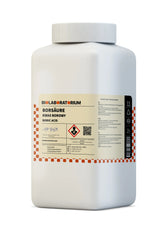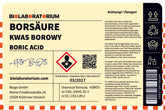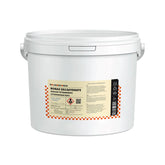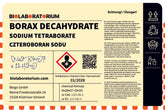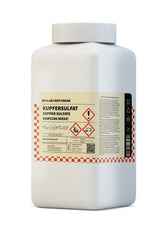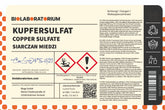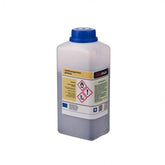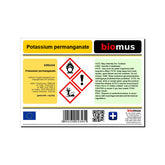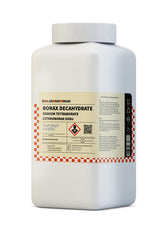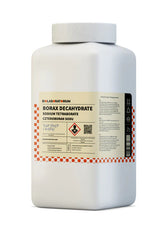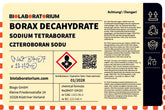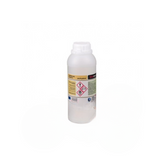Liebermann reagent – A classic reagent for the analysis of phenols and aromatics
In chemical analysis, there is a wide variety of useful reagents that scientists use for the identification and characterization of substances. One of these classical reagents is Liebermann's reagent, which is primarily used for the detection of phenols and aromatic compounds. In this blog post, we want to take a closer look at this versatile reagent and examine its application possibilities in qualitative analysis more closely.
The Composition of Liebermann's Reagent
Liebermann's reagent is a mixture of sodium nitrite (NaNO₂) and concentrated sulfuric acid (H₂SO₄). More precisely, it consists of a solution of sodium nitrite in concentrated sulfuric acid. This combination of reagents enables the characteristic color reaction used for the detection of phenols and aromatic compounds.
The exact composition can vary, but typically a concentration of about 1% sodium nitrite in concentrated sulfuric acid is used. It is important to always prepare the reagents fresh, as the reagent can lose reactivity over time.
The Mechanism of the Liebermann Reaction
The mechanism of the Liebermann reaction is based on the formation of nitrosophenols as intermediates. When Liebermann's reagent comes into contact with phenols or aromatic compounds, the sodium nitrite first reacts with sulfuric acid to form nitrous acid (HNO₂). This in turn nitrates the phenols at the ortho position, resulting in nitrosophenols.
These nitrosophenols are capable of reacting with excess sulfuric acid, forming characteristic color complexes. The color of the complex depends on the structure of the phenol and can range from blue through green to red.
The exact mechanism is complex and can vary depending on the substrate, but in general, the Liebermann reaction can be summarized as follows:
- Formation of nitrous acid from sodium nitrite and sulfuric acid
- Nitration of phenols at the ortho position
- Reaction of nitrosophenols with excess sulfuric acid under formation of color complexes
Applications of Liebermann's Reagent
Liebermann's reagent finds diverse applications in qualitative analysis, particularly in the detection and identification of phenols and aromatic compounds. Some examples of the reagent's use are:
1. Detection of Phenols
Phenols react with Liebermann's reagent to form characteristic color complexes. This detection is very specific for phenols and enables their identification in samples.
2. Analysis of Natural Substances
Many natural substances such as alkaloids, flavonoids, and terpenes contain phenolic structural elements. Using Liebermann's reagent, these substance classes can be qualitatively detected and distinguished.
3. Investigation of Pharmaceuticals
In pharmaceutical analysis, Liebermann's reagent is used to identify phenolic pharmaceuticals such as acetylsalicylic acid, paracetamol, or phenol.
4. Food Testing
Liebermann's reagent is also used in food analysis, for example, in the detection of phenolic compounds in wine, tea, or coffee.
5. Chemical Research
In chemical research, Liebermann's reagent serves as a useful tool to characterize and identify new compounds with phenolic structures.
Performance of the Liebermann Reaction
The practical application of Liebermann's reagent is relatively simple. Typically, a small amount of the substance to be examined is mixed with a few drops of the freshly prepared reagent. Subsequently, the color development is observed.
Depending on the structure of the phenol, a blue, green, or red coloration may occur. The intensity and nuance of the color provide initial clues about the type of phenolic compound present.
It is important to always prepare the reagent fresh, as it can lose reactivity over time. Additionally, one should be particularly careful when handling concentrated sulfuric acid and observe the corresponding safety measures.
Limitations and Restrictions
Although Liebermann's reagent is a very useful aid in qualitative analysis, there are also some limitations to consider:
- Not all phenols react equally strongly with the reagent, so the color intensity can vary.
- Some phenols show only a weak color reaction or even remain completely colorless.
- Other aromatic compounds without phenolic structure can also undergo a color reaction with Liebermann's reagent, which can lead to misinterpretations.
- The reagent is relatively non-specific and is therefore more suitable for a screening test than for a clear identification.
For these reasons, Liebermann's reagent should always be considered only as an aid in qualitative analysis. For a clear identification, additional, more specific analytical methods are usually required.
Conclusion
Liebermann's reagent is a classic and versatile aid in qualitative chemical analysis. With its help, phenols and aromatic compounds can be quickly and easily detected, and initial conclusions about their structure can be drawn.
Although the reagent has certain limitations, it remains a useful tool in the analysis of natural products, pharmaceuticals, and other phenolic substances. By combining it with further analytical methods, Liebermann's reagent can provide valuable services in chemical research and practice.

